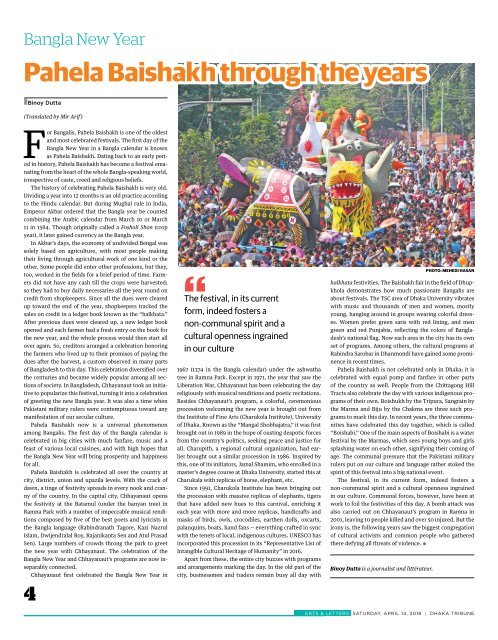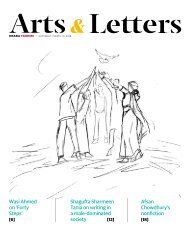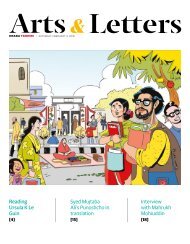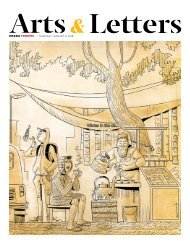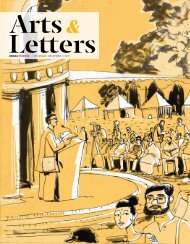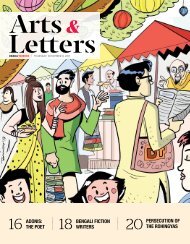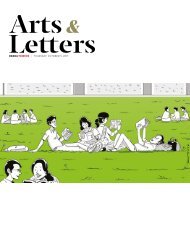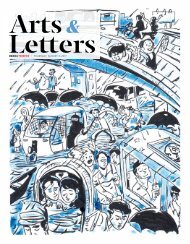Arts & Letters, April 2018
Create successful ePaper yourself
Turn your PDF publications into a flip-book with our unique Google optimized e-Paper software.
Bangla New Year<br />
Pahela Baishakh through the years<br />
•Binoy Dutta<br />
(Translated by Mir Arif )<br />
For Bangalis, Pahela Baishakh is one of the oldest<br />
and most celebrated festivals. The first day of the<br />
Bangla New Year in a Bangla calendar is known<br />
as Pahela Baishakh. Dating back to an early period<br />
in history, Pahela Baishakh has become a festival emanating<br />
from the heart of the whole Bangla-speaking world,<br />
irrespective of caste, creed and religious beliefs.<br />
The history of celebrating Pahela Baishakh is very old.<br />
Dividing a year into 12 months is an old practice according<br />
to the Hindu calendar. But during Mughal rule in India,<br />
Emperor Akbar ordered that the Bangla year be counted<br />
combining the Arabic calendar from March 10 or March<br />
11 in 1584. Though originally called a Fosholi Shon (crop<br />
year), it later gained currency as the Bangla year.<br />
In Akbar’s days, the economy of undivided Bengal was<br />
solely based on agriculture, with most people making<br />
their living through agricultural work of one kind or the<br />
other. Some people did enter other professions, but they,<br />
too, worked in the fields for a brief period of time. Farmers<br />
did not have any cash till the crops were harvested;<br />
so they had to buy daily necessaries all the year round on<br />
credit from shopkeepers. Since all the dues were cleared<br />
up toward the end of the year, shopkeepers tracked the<br />
sales on credit in a ledger book known as the “halkhata.”<br />
After previous dues were cleared up, a new ledger book<br />
opened and each farmer had a fresh entry on the book for<br />
the new year, and the whole process would then start all<br />
over again. So, creditors arranged a celebration honoring<br />
the farmers who lived up to their promises of paying the<br />
dues after the harvest, a custom observed in many parts<br />
of Bangladesh to this day. This celebration diversified over<br />
the centuries and became widely popular among all sections<br />
of society. In Bangladesh, Chhayanaut took an initiative<br />
to popularize this festival, turning it into a celebration<br />
of greeting the new Bangla year. It was also a time when<br />
Pakistani military rulers were contemptuous toward any<br />
manifestation of our secular culture.<br />
Pahela Baishakh now is a universal phenomenon<br />
among Bangalis. The first day of the Bangla calendar is<br />
celebrated in big cities with much fanfare, music and a<br />
feast of various local cuisines, and with high hopes that<br />
the Bangla New Year will bring prosperity and happiness<br />
for all.<br />
Pahela Baishakh is celebrated all over the country at<br />
city, district, union and upazila levels. With the crack of<br />
dawn, a tinge of festivity spreads in every nook and cranny<br />
of the country. In the capital city, Chhayanaut opens<br />
the festivity at the Batamul (under the banyan tree) in<br />
Ramna Park with a number of impeccable musical renditions<br />
composed by five of the best poets and lyricists in<br />
the Bangla language (Rabindranath Tagore, Kazi Nazrul<br />
Islam, Dwijendralal Roy, Rajanikanta Sen and Atul Prasad<br />
Sen). Large numbers of crowds throng the park to greet<br />
the new year with Chhayanaut. The celebration of the<br />
Bangla New Year and Chhayanaut’s programs are now inseparably<br />
connected.<br />
4<br />
Chhayanaut first celebrated the Bangla New Year in<br />
The festival, in its current<br />
form, indeed fosters a<br />
non-communal spirit and a<br />
cultural openness ingrained<br />
in our culture<br />
1967 (1374 in the Bangla calendar) under the ashwatha<br />
tree in Ramna Park. Except in 1971, the year that saw the<br />
Liberation War, Chhayanaut has been celebrating the day<br />
religiously with musical renditions and poetic recitations.<br />
Besides Chhayanaut’s program, a colorful, ceremonious<br />
procession welcoming the new year is brought out from<br />
the Institute of Fine <strong>Arts</strong> (Charukola Institute), University<br />
of Dhaka. Known as the “Mangal Shobhajatra,” it was first<br />
brought out in 1989 in the hope of ousting despotic forces<br />
from the country’s politics, seeking peace and justice for<br />
all. Charupith, a regional cultural organization, had earlier<br />
brought out a similar procession in 1986. Inspired by<br />
this, one of its initiators, Jamal Shamim, who enrolled in a<br />
master’s degree course at Dhaka University, started this at<br />
Charukala with replicas of horse, elephant, etc.<br />
Since 1991, Charukola Institute has been bringing out<br />
the procession with massive replicas of elephants, tigers<br />
that have added new hues to this carnival, enriching it<br />
each year with more and more replicas, handicrafts and<br />
masks of birds, owls, crocodiles, earthen dolls, oxcarts,<br />
palanquins, boats, hand fans -- everything crafted in sync<br />
with the tenets of local, indigenous cultures. UNESCO has<br />
incorporated this procession in its “Representative List of<br />
Intangible Cultural Heritage of Humanity” in 2016.<br />
Apart from these, the entire city buzzes with programs<br />
and arrangements marking the day. In the old part of the<br />
city, businessmen and traders remain busy all day with<br />
PHOTO: MEHEDI HASAN<br />
halkhata festivities. The Baishakh fair in the field of Dhupkhola<br />
demonstrates how much passionate Bangalis are<br />
about festivals. The TSC area of Dhaka University vibrates<br />
with music and thousands of men and women, mostly<br />
young, hanging around in groups wearing colorful dresses.<br />
Women prefer green saris with red lining, and men<br />
green and red Punjabis, reflecting the colors of Bangladesh’s<br />
national flag. Now each area in the city has its own<br />
set of programs. Among others, the cultural programs at<br />
Rabindra Sarobar in Dhanmondi have gained some prominence<br />
in recent times.<br />
Pahela Baishakh is not celebrated only in Dhaka; it is<br />
celebrated with equal pomp and fanfare in other parts<br />
of the country as well. People from the Chittagong Hill<br />
Tracts also celebrate the day with various indigenous programs<br />
of their own. Boishukh by the Tripura, Sangrain by<br />
the Marma and Biju by the Chakma are three such programs<br />
to mark this day. In recent years, the three communities<br />
have celebrated this day together, which is called<br />
“Boishabi.” One of the main aspects of Boishabi is a water<br />
festival by the Marmas, which sees young boys and girls<br />
splashing water on each other, signifying their coming of<br />
age. The communal pressure that the Pakistani military<br />
rulers put on our culture and language rather stoked the<br />
spirit of this festival into a big national event.<br />
The festival, in its current form, indeed fosters a<br />
non-communal spirit and a cultural openness ingrained<br />
in our culture. Communal forces, however, have been at<br />
work to foil the festivities of this day. A bomb attack was<br />
also carried out on Chhayanaut’s program in Ramna in<br />
2001, leaving 10 people killed and over 50 injured. But the<br />
irony is, the following years saw the biggest congregation<br />
of cultural activists and common people who gathered<br />
there defying all threats of violence. •<br />
Binoy Dutta is a journalist and littérateur.<br />
ARTS & LETTERS SATURDAY, APRIL 14, <strong>2018</strong> | DHAKA TRIBUNE


